Probabilistic Studies on the Shear Strength of Slender Steel Fiber Reinforced Concrete Structures
Abstract
:1. Introduction
2. Objectives of the Investigation
3. Shear Formulations and Experimental Database for SFRC Beams without Shear Reinforcements
3.1. Shear Resistance Formulation
3.1.1. German Guideline (DAfStB) [19]
3.1.2. Model Code 2010 [20]
3.1.3. Bernat et al. [27] Mechanical Model
3.2. Experimental Database SFRC Slender Beams
4. Deterministic Performance Assessment of Shear Design Formulations for SFRC Beams
5. Quantification of Model Uncertainties in SFRC Shear Resistance Models
5.1. Methodology to Assess the Resistance Model Uncertainties
5.2. Statistical Properties of the Model Uncertainty Random Variable
5.3. Assessment of Model Uncertainty Independence and Correlations
5.4. Probabilistic Model for Model Uncertainty
6. Derivation of Partial Safety Factor for Resistance Model Uncertainties
7. Conclusions
- The model uncertainty related to the DAfStB model has a mean value of (the closest to the optimal value of 1) and the lowest dispersion . On the other hand, the MC-10 and Bernat et al., models displayed the highest mean value (largest conservative bias) and the most substantial dispersion, comparatively.
- The Bernat et al., model showed weak to moderately weak trend with all the shear parameters investigated in this study. MC-10 and DAfStB models showed some correlation of the model uncertainty with the beam effective depth , shear span to effective depth and the reinforcement ratio , corresponding to unwanted trends in the model uncertainty with these parameters.
- The shear span to effective depth ratio was found to be the most influential parameter (highest correlation coefficient). The strong decreasing trend of safety bias as the shear span to effective depth ratio increases, is a cause for concern. Further assessment of this trend was conducted by computing model uncertainty statistics for different subsets of beams with ratio. The parameter range analysis indicates that the statistics of the model uncertainty (mean value, standard deviation and coefficient of variation) decreases with increasing ratio.
- The probability distribution fitting indicates that the derived model uncertainty random variables can be modelled using a lognormal distribution.
- Global partial safety factors accounting for the model uncertainty in shear resistance models for SFRC beams were proposed. Partial safety factors ranging from 1.13–1.23, 1.17–1.22 and 1.38–1.64 were recommended for beams with short, medium and slender shear span lengths, respectively. It is important to note that improved values of the global partial safety factors can be obtained using a fully probabilistic approach.
- The derived model uncertainty variables and related partial safety factors obtained in this study are associated with the specific database considered, which may change noticeably should the database change. However, the database presented in this study may be regarded as representative of practical design situations.
- The use of partial factors ensures a consistent level of reliability over a range of structures. This enables engineers with no knowledge of probability and reliability theory to produce designs at a prescribed level of reliability.
Author Contributions
Funding
Conflicts of Interest
References
- Ulzurrun, G.S.; Zanuy, C. Enhancement of impact performance of reinforced concrete beams without stirrups by adding steel fibers. Constr. Build. Mater. 2017, 145, 166–182. [Google Scholar] [CrossRef]
- Padmarajaiah, S.K.; Ramaswamy, A. Flexural strength predictions of steel fiber reinforced high-strength concrete in fully/partially prestressed beam specimens. Cem. Concr. Compos. 2004, 26, 275–290. [Google Scholar] [CrossRef]
- Zarrinpour, M.R.; Chao, S.H. Shear Strength Enhancement Mechanisms of Steel Fiber-Reinforced Concrete Slender Beams. ACI Struct. J. 2017, 114, 729–742. [Google Scholar] [CrossRef]
- Köksal, F.; Şahin, Y.; Beycioğlu, A.; Gencel, O.; Brostow, W. Estimation of fracture energy of high-strength steel fibre-reinforced concrete using rule-based Mamdani-type fuzzy inference system. Sci. Eng. Compos. Mater. 2012, 19, 373–380. [Google Scholar] [CrossRef]
- Dinh, H.H.; Parra-Montesinos, G.J.; Wight, J.K. Shear behavior of steel fiber-reinforced concrete beams without stirrup reinforcement. ACI Struct. 2010, 597–606. [Google Scholar] [CrossRef]
- Kang, T.H.K.; Kim, W.; Kwak, Y.K.; Hong, S.G. Shear Testing of Steel Fiber-Reinforced Lightweight Concrete Beams without Web Reinforcement. Aci Struct. J. 2011, 108, 553–560. [Google Scholar]
- Greenough, T.; Nehdi, M. Shear behavior of fiber-reinforced self-consolidating concrete slender beams. Aci Struct. J. 2008, 105, 468. [Google Scholar]
- Gandomi, A.H.; Alavi, A.H.; Yun, G.J. Nonlinear modeling of shear strength of SFRC beams using linear genetic programming. Struct. Eng. Mech. 2011, 38, 1–25. [Google Scholar] [CrossRef]
- Ahmadi, M.; Kheyroddin, A.; Dalvand, A.; Kioumarsi, M. New empirical approach for determining nominal shear capacity of steel fiber reinforced concrete beams. Constr. Build. Mater. 2020, 234, 117293. [Google Scholar] [CrossRef]
- Slater, E.; Moni, M.; Alam, M.S. Predicting the shear strength of steel fiber reinforced concrete beams. Constr. Build. Mater. 2012, 26, 423–436. [Google Scholar] [CrossRef]
- Arslan, G. Shear strength of steel fiber reinforced concrete (SFRC) slender beams. KSCE J. Civ. Eng. 2014, 18, 587–594. [Google Scholar] [CrossRef]
- Minelli, F. Plain and Fiber Reinforced Concrete Beams under Shear Loading: Structural Behavior and Design Aspects; University of Brescia: Brescia, Italy, 2005. [Google Scholar]
- Rosenbusch, J.; Teutsch, M. Shear design with (σ-ε) method. In International RILEM Workshop on Test and Design Methods for Steelfibre Reinforced Concrete; Schnütgen, B., Vandewalle, L., Eds.; RILEM: Paris, France, 2003; pp. 105–117. [Google Scholar]
- Wight, J.K.; MacGregor, J.G. Reinforced Concrete: Mechanics and Design, 5th ed.; Pearson Prentice Hall: Upper Saddle River, NJ, USA, 2008; pp. 247–248. [Google Scholar]
- Mansur, M.A.; Ong KC, G.; Paramasivam, P. Shear strength of fibrous concrete beams without stirrups. J. Struct. Eng. 1986, 112, 2066–2079. [Google Scholar] [CrossRef]
- Lantsoght, E.O.L. How do steel fibers improve the shear capacity of reinforced concrete beams without stirrups? Comp. Part B Eng. 2019, 175, 107079. [Google Scholar] [CrossRef]
- Kani, G.N.J. Basic facts concerning shear failure. ACI J. Proc. 1966, 63, 675–692. [Google Scholar]
- Association Française de Génie Civil. Bétons Fibrés à Ultra-Hautes Performances: Recommandations; Association Française de Génie Civil: Paris, France, 2013; p. 359. [Google Scholar]
- DAfStB. DAfStB-Richtlinie Stahlfaserbeton; DIN: Berlin, Germany, 2012; p. 47. [Google Scholar]
- FIB. Model Code 2010; Final Draft; International Federation for Structural Concrete: Lausanne, Switzerland, 2012; p. 676. [Google Scholar]
- Lantsoght, E.O. Database of shear experiments on steel fiber reinforced concrete beams without stirrups. Materials 2019, 12, 917. [Google Scholar] [CrossRef] [Green Version]
- Foster, S.J. Design of FRC beams for shear using the VEM and the draft model code approach. Fib Bull. 2010, 57, 195–210. [Google Scholar]
- Matthys, S.; Soetens, T. Engineering Model for SFRC Shear Strength Based on MC2010 MCFT Approach. In High Tech Concrete: Where Technology and Engineering Meet; Springer: Cham, Switzerland, 2018; pp. 374–381. [Google Scholar]
- Lee, D.H.; Kim, K.S.; Han, S.J.; Zhang, D.; Kim, J. Dual potential capacity model for reinforced concrete short and deep beams subjected to shear. Struct. Concr. 2018, 19, 76–85. [Google Scholar] [CrossRef] [Green Version]
- Colajanni, P.; Recupero, A.; Spinella, N. Generalisation of shear truss model to the case of SFRC beams with stirrups. Comput Concr. 2012, 9, 227–244. [Google Scholar] [CrossRef]
- Spinella, N.; Colajanni, P.; Recupero, A. Simple plastic model for shear critical SFRC beams. J Struct. Eng. 2010, 136, 390–400. [Google Scholar] [CrossRef] [Green Version]
- Bernat, A.M.; Spinella, N.; Recupero, A.; Cladera, A. Mechanical model for the shear strength of steel fiber reinforced concrete (SFRC) beams without stirrups. Mater. Struct. 2020, 53, 1–20. [Google Scholar]
- Holický, M.; Retief, J.V.; Sýkora, M. Assessment of model uncertainties for structural resistance. Probab. Eng. Mech. 2016, 45, 188–197. [Google Scholar] [CrossRef]
- Olalusi, O.B.; Viljoen, C. Model uncertainties and bias in SHEAR strength predictions of slender stirrup reinforced concrete beams. Struct. Concr. 2020, 21, 316–332. [Google Scholar] [CrossRef]
- Olalusi, O.B.; Viljoen, C. Assessment of reliability of EN 1992-1-1 variable strut inclination method of shear design provisions for stirrup failure. Struct. Concr. 2020, 21, 303–315. [Google Scholar] [CrossRef]
- Hamutcuoglu, O.M. Parametric Uncertainties in Reliability Analysis of Bridge Structures; Oregon State University: Corvallis, OR, USA, 2010. [Google Scholar]
- Thomas, J.; Ramaswamy, A. Mechanical properties of steel fiber-reinforced concrete. J. Mater. Civ. Eng. 2007, 19, 385–392. [Google Scholar] [CrossRef]
- JCSS. JCSS Probabilistic Model Code; Joint Committee on Structural Safety: Zurich, Swizerland, 2001; ISBN 978-3-909386-79-6. [Google Scholar]
- Song, J.; Kang, W.H.; Kim, K.S.; Jung, S. Probabilistic shear strength models for reinforced concrete beams without shear reinforcement. Struct. Eng. Mech. 2010, 11, 15. [Google Scholar] [CrossRef] [Green Version]
- Olalusi, O.B. Reliability Assessment of Shear Design Provisions for Reinforced Concrete Beams with Stirrups. Ph.D. Thesis, Stellenbosch University, Stellenbosch, South Africa, 2018. [Google Scholar]
- EN 1992-2. Design of Concrete Structures- Concrete Bridges—Design and Detailing Rules; European Standard, European Committee for Standardization: Brussels, Belgium, 2005. [Google Scholar]
- Olalusi, O.B.; Spyridis, P. Uncertainty modelling and analysis of the concrete edge breakout resistance of single anchors in shear. Eng. Struct. 2020, 222, 111112. [Google Scholar] [CrossRef]
- EN 1990. Eurocode—Basis of Structural Design; European Standard, European Committee for Standardization: Brussels, Belgium, 2002. [Google Scholar]
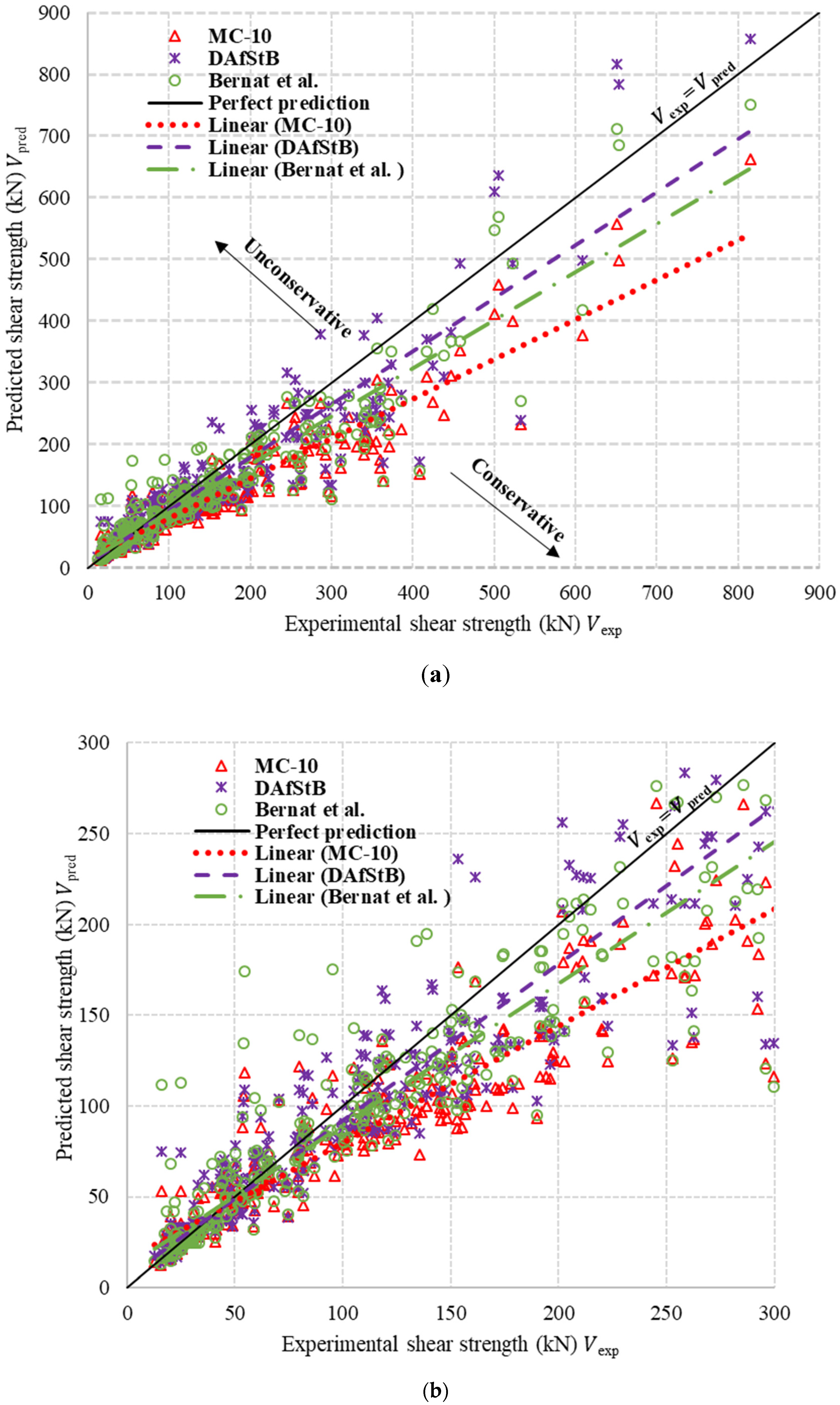
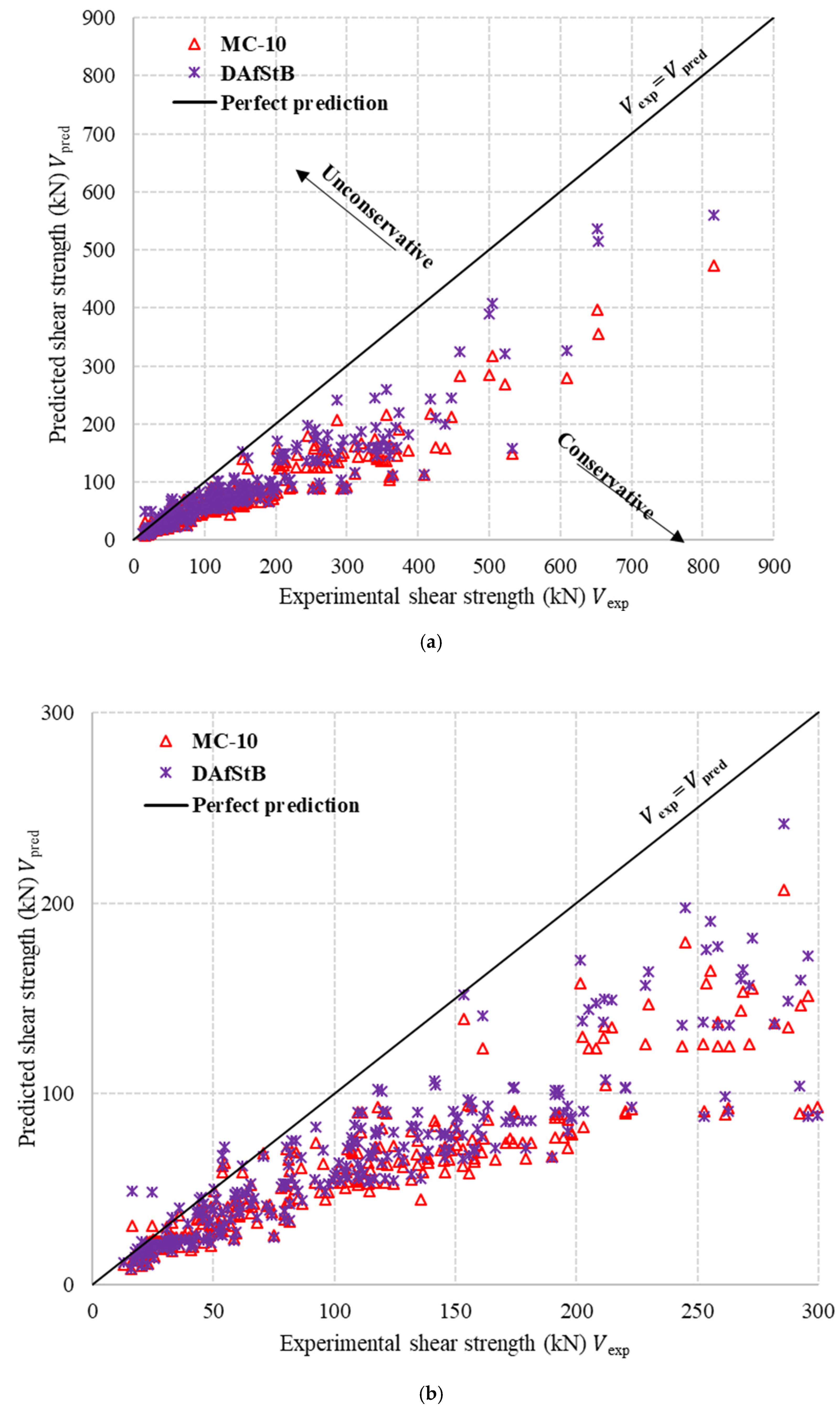

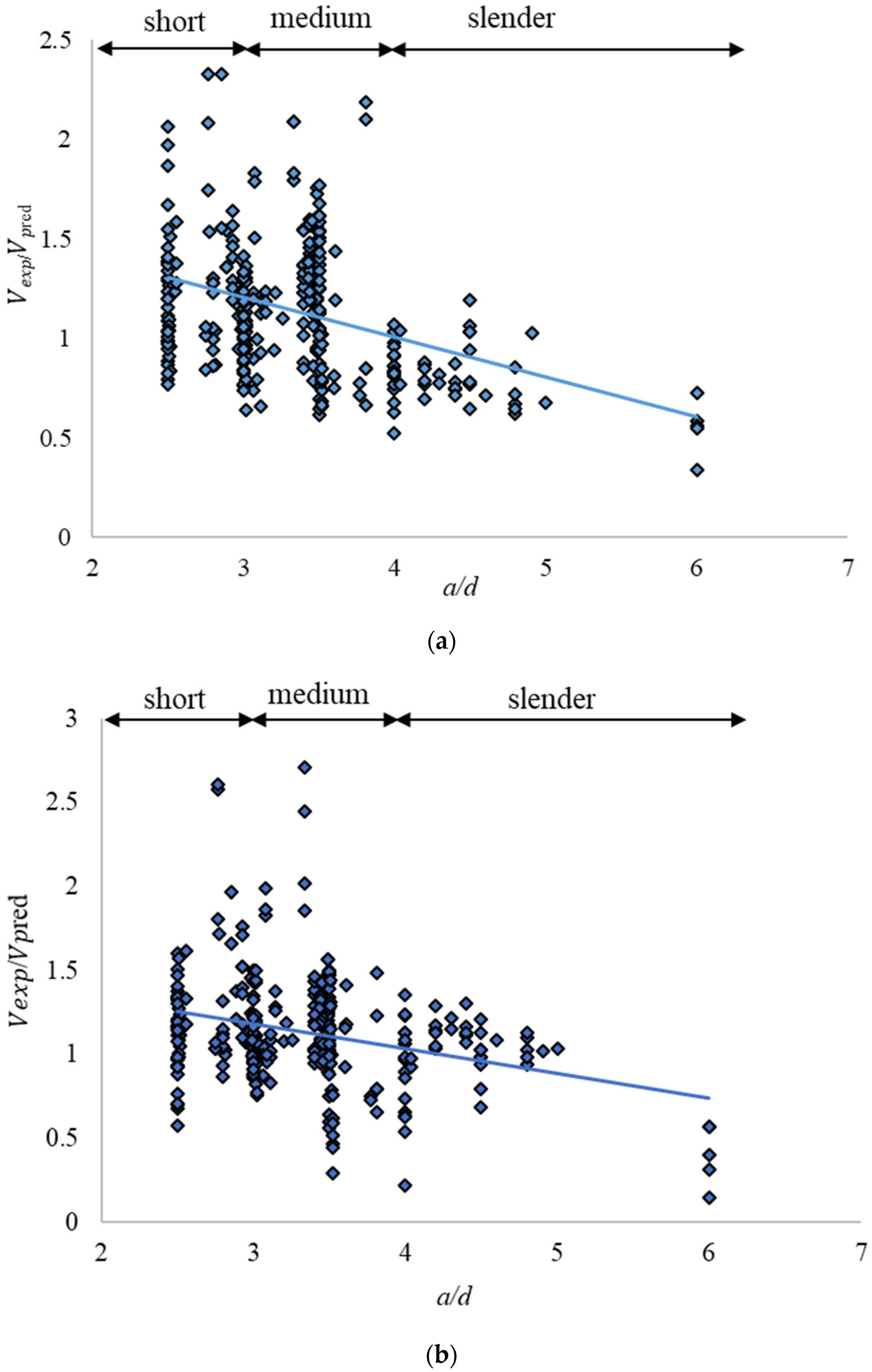
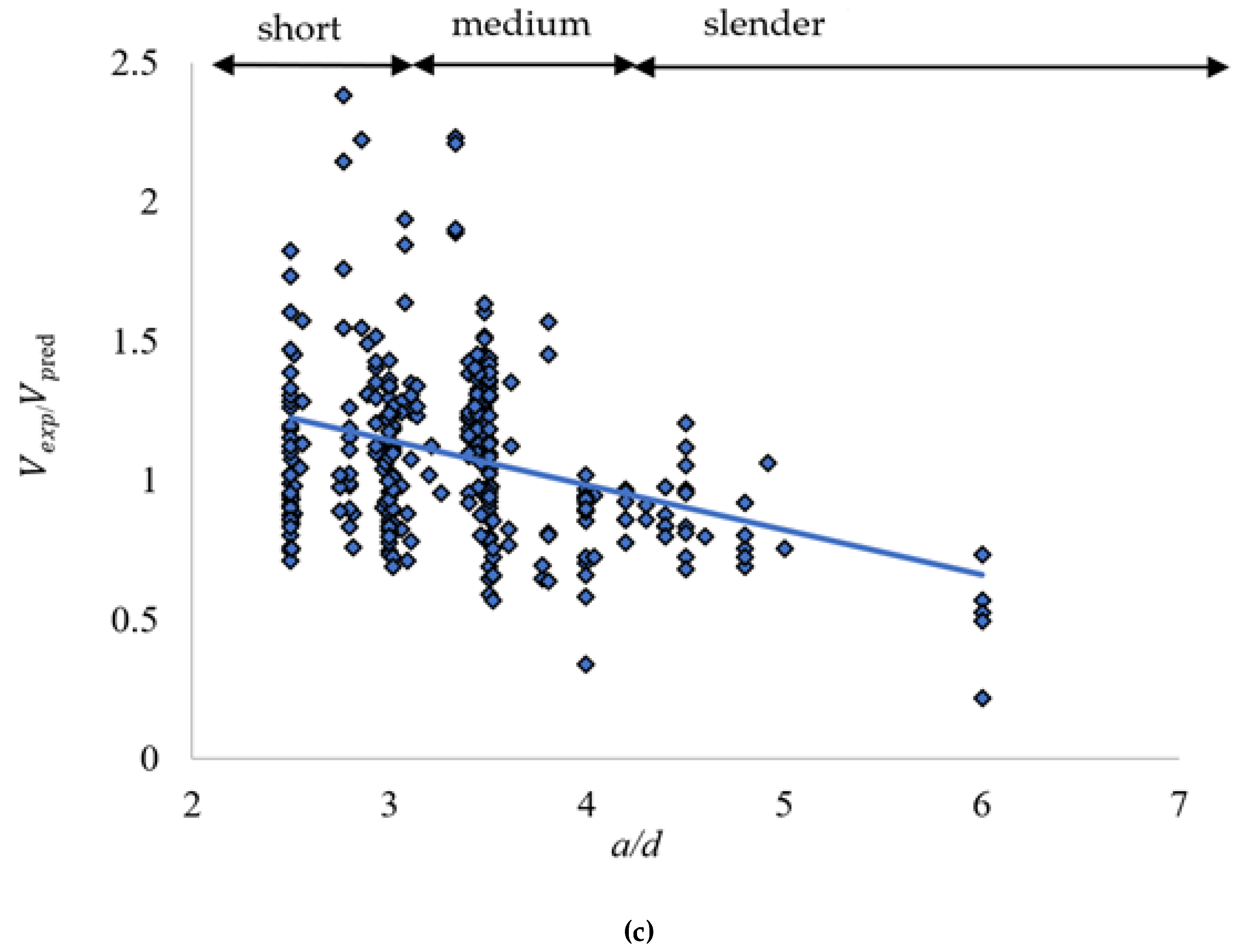
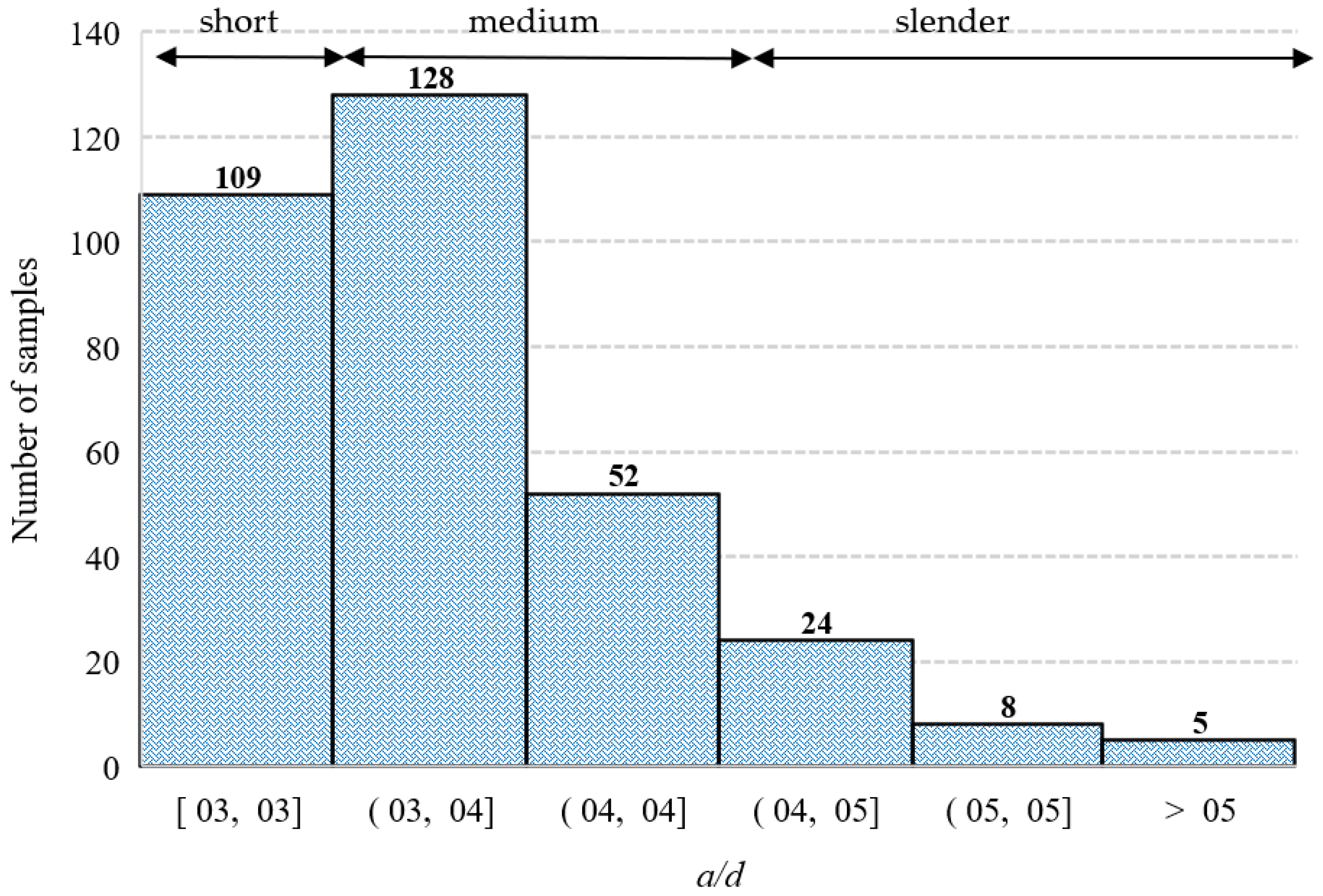
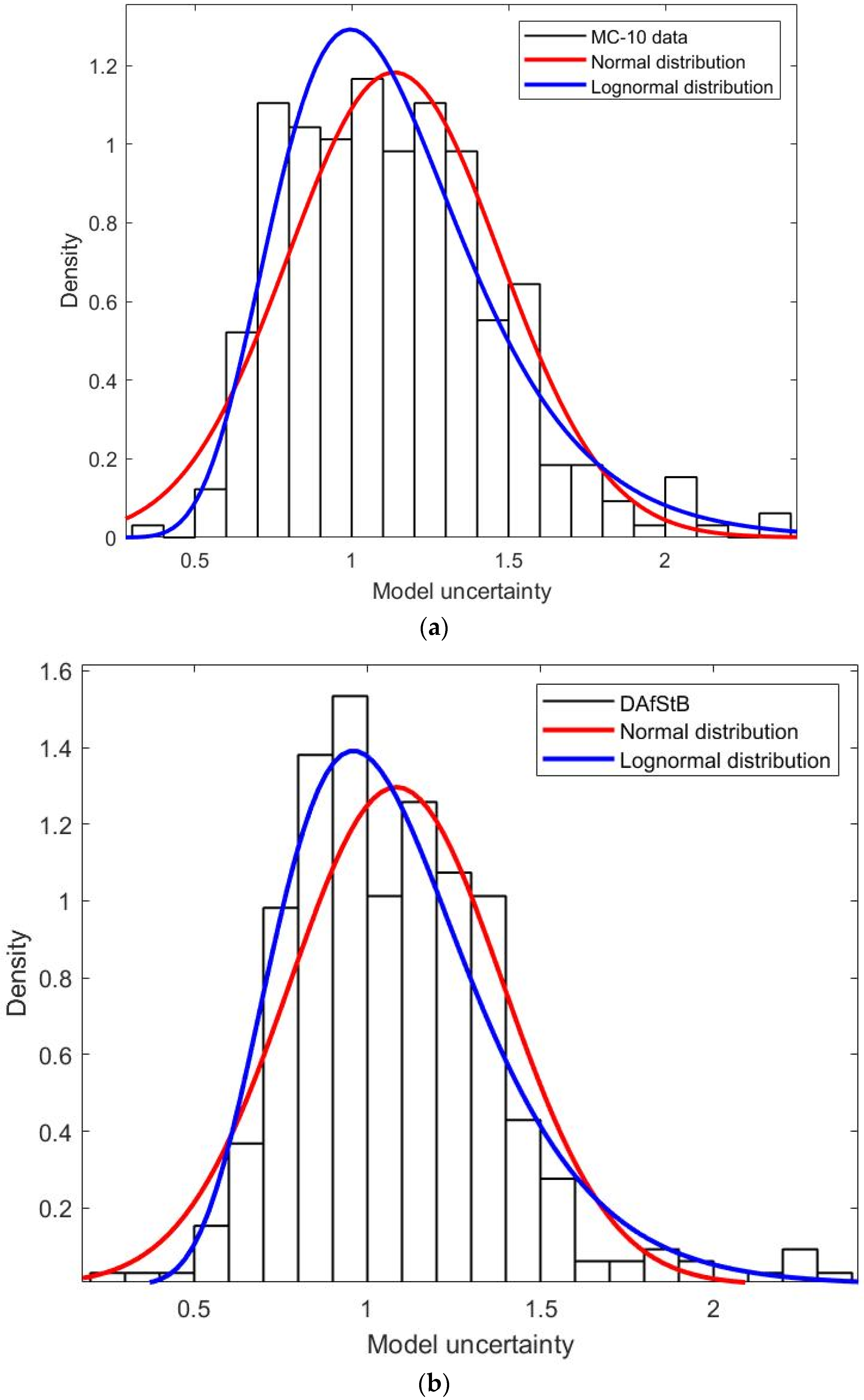


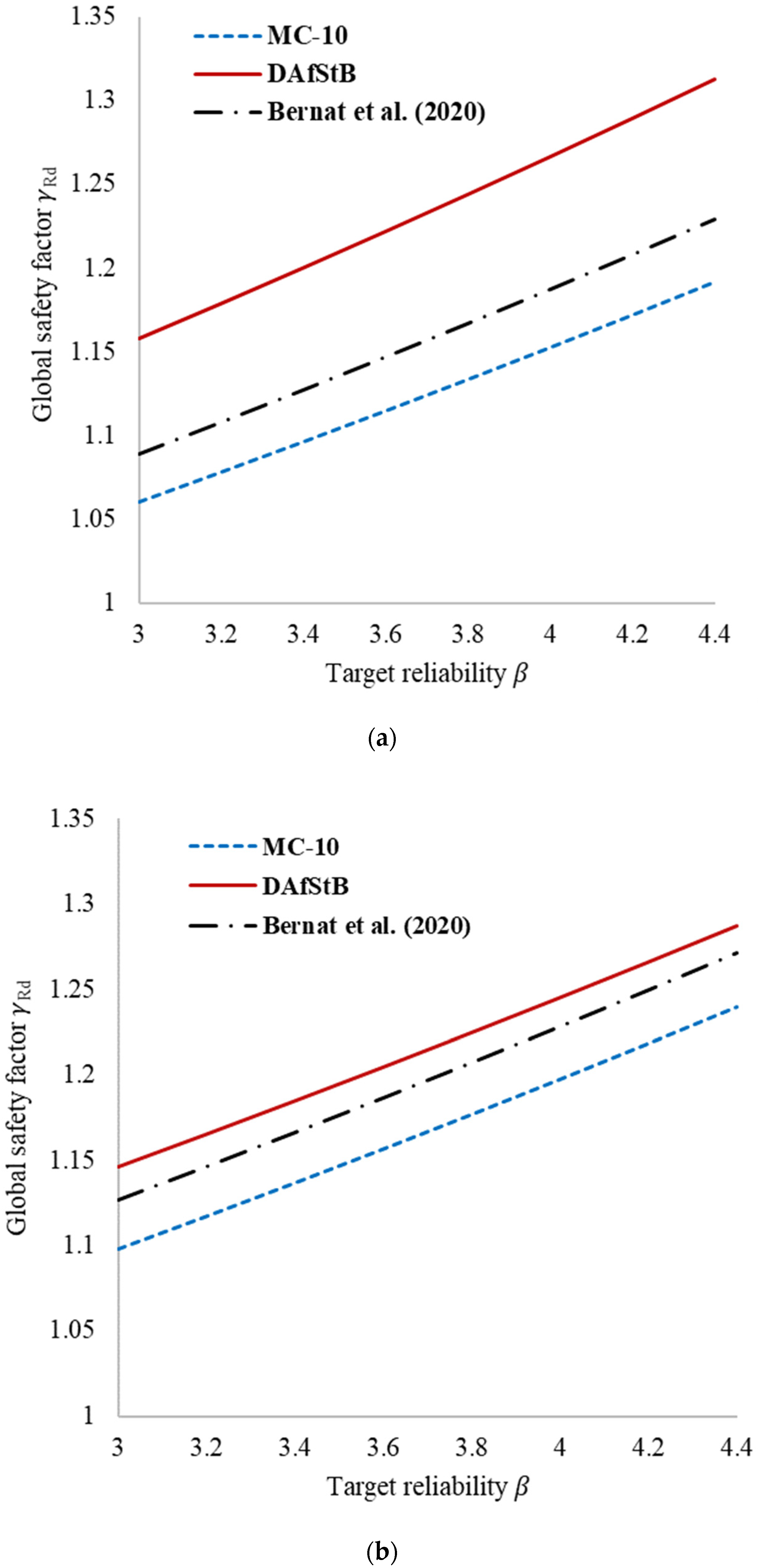
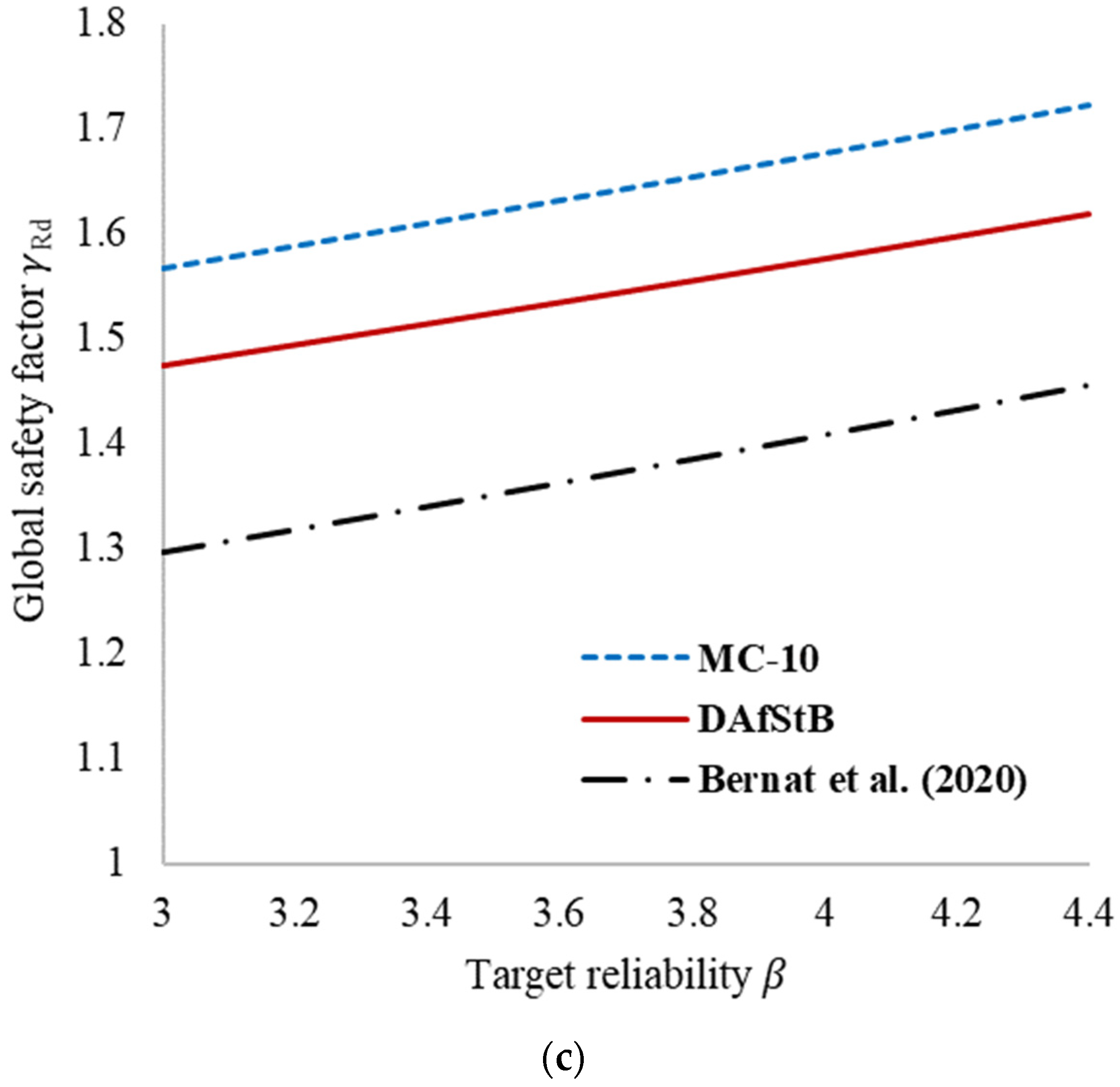
| Model | Sample Size # | Source | ||
|---|---|---|---|---|
| Fib Model Code (MC-10) [20] | 1.24 | 0.36 | 488 (Slender and non-slender beams) | [21] |
| DAfStB [19] | 1.12 | 0.31 | 488 (Slender and non-slender beams) | [21] |
| Bernat et al. [27] | 1.15 | 0.25 | 488 (Slender and non-slender beams) | [27] |
| Bernat et al. [27] | 1.17 | 0.28 | 82 (Slender and non-slender beams) | [27] |
| Parameters | Range | Min | Max | Mean | S.D. | C.o.V. |
|---|---|---|---|---|---|---|
| (kN) | 686.64 | 12.89 | 699.53 | 134.44 | 128.75 | 0.96 |
| (-) | 1.90 | 0.10 | 2.00 | 0.51 | 0.31 | 0.62 |
| (mm) | 21.60 | 0.40 | 22.00 | 9.94 | 5.23 | 0.53 |
| 0.053 | 0.004 | 0.057 | 0.03 | 0.01 | 0.38 | |
| (MPa) | 205.23 | 9.77 | 215.00 | 49.33 | 26.94 | 0.55 |
| (-) | 3.50 | 2.50 | 6.00 | 3.37 | 0.66 | 0.20 |
| (mm) | 255.00 | 55.00 | 310.00 | 151.96 | 57.77 | 0.38 |
| (mm) | 837.75 | 85.25 | 923.00 | 264.15 | 160.46 | 0.61 |
| Parameters | MC-10 | DAfStB | Bernat et al. |
|---|---|---|---|
| Number of experiments | 326 | 326 | 326 |
| Mean | 1.13 | 1.08 | 1.13 |
| Standard deviation | 0.34 | 0.31 | 0.33 |
| Coefficient of variation | 30% | 29% | 29% |
| Skewness | 0.65 | 0.84 | 0.99 |
| Range | 2.03 | 2.16 | 2.56 |
| Minimum ( | 0.30 | 0.22 | 0.15 |
| Maximum | 2.33 | 2.38 | 2.71 |
| MC-10 | DAfStB | Bernat et al. | |
|---|---|---|---|
| 0.22 | 0.07 | 0.17 | |
| 0.34 | 0.10 | 0.15 | |
| 0.13 | 0.33 | 0.29 | |
| −0.38 | −0.34 | −0.29 | |
| 0.15 | 0.14 | 0.08 | |
| 0.22 | 0.14 | −0.31 |
| MC-10 | DAfStB | Bernat et al. | |||||||
|---|---|---|---|---|---|---|---|---|---|
| Description of the Sample | |||||||||
| Short shear span length () | 1.21 | 0.32 | 0.26 | 1.13 | 0.31 | 0.28 | 1.19 | 0.32 | 0.27 |
| Medium Shear Span Length () | 1.18 | 0.32 | 0.27 | 1.12 | 0.29 | 0.26 | 1.15 | 0.31 | 0.27 |
| Slender Shear Span Length () | 0.78 | 0.16 | 0.21 | 0.83 | 0.18 | 0.21 | 0.99 | 0.26 | 0.26 |
| Parameter Range | MC-10 | Bernat et al. [27] | DAfStB | |||
|---|---|---|---|---|---|---|
| Range of model uncertainty partial factor | Recommended value | Range of model uncertainty partial factor | Recommended value | Range of model uncertainty partial factor | Recommended value | |
| Short shear span length | 1.06–1.19 | ≈1.13 | 1.08–1.23 | 1.16 | 1.16–1.31 | ≈1.23 |
| Medium shear span length | 1.10–1.24 | ≈1.17 | 1.13–1.27 | 1.20 | 1.15–1.29 | ≈1.22 |
| Slender shear span length | 1.57–1.72 | ≈1.64 | 1.30–1.45 | 1.38 | 1.47–1.62 | ≈1.55 |
© 2020 by the authors. Licensee MDPI, Basel, Switzerland. This article is an open access article distributed under the terms and conditions of the Creative Commons Attribution (CC BY) license (http://creativecommons.org/licenses/by/4.0/).
Share and Cite
Olalusi, O.B.; Spyridis, P. Probabilistic Studies on the Shear Strength of Slender Steel Fiber Reinforced Concrete Structures. Appl. Sci. 2020, 10, 6955. https://doi.org/10.3390/app10196955
Olalusi OB, Spyridis P. Probabilistic Studies on the Shear Strength of Slender Steel Fiber Reinforced Concrete Structures. Applied Sciences. 2020; 10(19):6955. https://doi.org/10.3390/app10196955
Chicago/Turabian StyleOlalusi, Oladimeji B., and Panagiotis Spyridis. 2020. "Probabilistic Studies on the Shear Strength of Slender Steel Fiber Reinforced Concrete Structures" Applied Sciences 10, no. 19: 6955. https://doi.org/10.3390/app10196955






